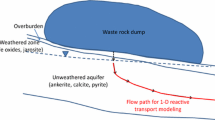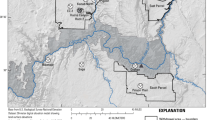Abstract
Numerical flow simulations with common hydraulic conductivity/depth distributions result in an active and passive turn-over zone, both occurring world wide. Geochemical modeling of uranium species distribution under oxidizing conditions in carbonate and sulfate waters mostly yields negatively charged or neutral UO2-carbonate complexes, which do not sorbe on negatively charged mineral surfaces (pH 5 to 8), which is in good agreement with batch experiments. Contrary, in crystalline aquifers Uranium species are mostly positively charged, favoring sorption. Dilution in the passive turn-over zone is dominated by transverse hydro-dynamic dispersion and gets enhanced by orders of magnitudes in bi-porous sediments through matrix diffusion. At the transition from the passive into the active turn-over zone dilution gets further enhanced.
Access this chapter
Tax calculation will be finalised at checkout
Purchases are for personal use only
Preview
Unable to display preview. Download preview PDF.
Similar content being viewed by others
References
Wolfrum C, Klotz D, Bode W (1988) Bestimmung des Sorptions-Desorptionserhaltens ausgewählter Radionuklide an Sedimentproben des Asse-Deckgebirges. GSF-Bericht 25/88
Engelhardt v. W (1960) Der Porenraum der Sedimente. 207 p, (Springer) Berlin
Freeze R A, Witherspoon P A (1967) Theoretical analysis of regional groundwater flow: 2. Effect of water table configuration and subsurface permeability variations. Water Resources Res. 3 623-634
Gherguth J, Maloszewski P, Seiler K-P (2001) Age, environmental isotope, and contaminant transport uncoupling in heterogeneous aquifers following hydraulic stress. In: Seiler K.-P. and Wohnlich S. (Eds.): New Approaches Characterizing Groundwater Flow, Vol. 1,327-334
Papelis C, Hayes K F, Leckie J O (1988) Hydraql: A Program for the computation of chemical equilibrium composition of aqueous batch systems including surface com-plexation modelling of ion adsorption at the oxid/solution interface. Stanford University California, Technical report No. 306, Sept. 1988
Seiler K-P, Lindner W (1995) Near surface and deep groundwater. J. Hydrol. 165, 33-44; Amsterdam
Sudicky E A, Frind E O 1981 Carbon-14 dating of groundwater in confined aquifers: Implication of aquitard diffusion. Water Res. Research 17, 1060-1064
Author information
Authors and Affiliations
Editor information
Editors and Affiliations
Rights and permissions
Copyright information
© 2002 Springer-Verlag Berlin Heidelberg
About this paper
Cite this paper
Seiler, K.P., Graf, W., Lang, H., Zapata, R. (2002). Groundwater flow systems and the export of uranium from nuclear waste repositories to the biosphere. In: Merkel, B.J., Planer-Friedrich, B., Wolkersdorfer, C. (eds) Uranium in the Aquatic Environment. Springer, Berlin, Heidelberg. https://doi.org/10.1007/978-3-642-55668-5_25
Download citation
DOI: https://doi.org/10.1007/978-3-642-55668-5_25
Publisher Name: Springer, Berlin, Heidelberg
Print ISBN: 978-3-642-62877-1
Online ISBN: 978-3-642-55668-5
eBook Packages: Springer Book Archive




